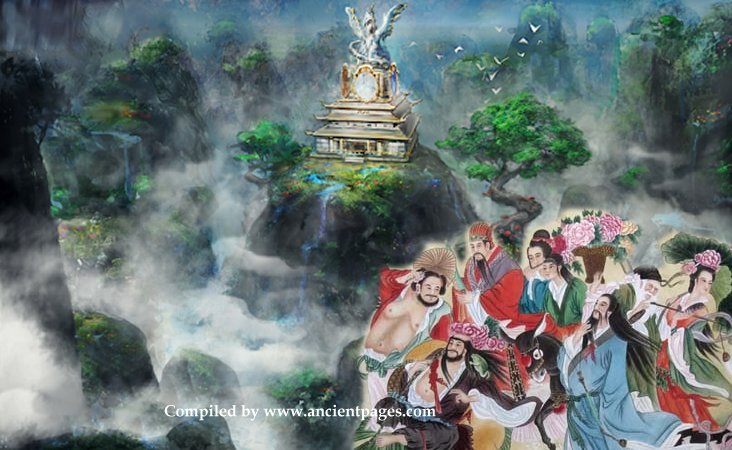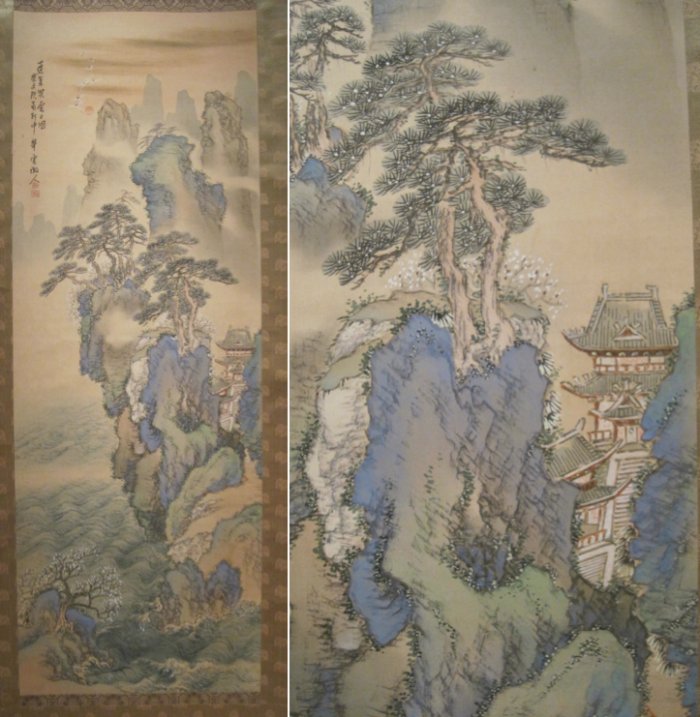Legendary Mount Penglai Where The Eight Immortals Reside
Ellen Lloyd - AncientPages.com - Mount Penglai is shrouded in mystery. It is a legendary land that many have tried to locate, but so far no one has succeeded in finding the mythological place where all living creatures are believed to be white.
Palaces are made from gold and platinum, and jewelry grows on trees. If the place truly exists, it has remained hidden from humans.
In Chinese mythology, Mount Penglai is the home of the Eight Immortals who we discussed previously on Ancient Pages.
The Eight Immortals knew the secrets of nature. These mysterious beings are regarded as super-humans who control all aspects of life. Each of the individual immortal’s power can be transferred to a tool of power that can give life or destroy evil.
The Eight Immortals are said to live on Penglai Mountain-Island, but the location of their home remains an unsolved mystery. Mount Penglai is also the home of Anqi Sheng, an immortal Chinese wizard.
Qin Shi Huang Search For Penglai Mountain And The Elixir Of Life
Qin Shi Huang, the First Emperor of a unified China, who ruled from 246 BCE to 210 BCE tried to several times find Mount Penglai. Qin Shi Huang learned that only immortals could reach the mysterious land where there is no winter.
Some ancient books mentioned Mount Penglai and Qin Shi Huang who was determined to obtain the herb of immortality that was said to grow there, set out an expedition to search for the lands of the Eight Immortals. However, no matter how hard he tried, Qin Shi Huang Huang couldn’t locate Mount Penglai and his quest for the elixir of life failed.
Like most mythological places inhabited by god-like beings, Mount Penglai is described as a paradise where there is no pain, hunger, or disease. People live in perfect harmony and magical fruits growing in Penglai can heal any disease, grant eternal youth, and even raise the dead. There is never any shortage of food. Rice bowls and wine glasses never become empty no matter how much people eat or drink from them.
Mount Penglai is said to be in the Bohai sea, off the Chinese coast. Credit: Yuan Jiang
The Liezi, a Daoist book attributed to Lie Yukou contains several stories about Daoist adepts trying to achieve longevity. The book mentions five islands that were called Penglai, Yingzhou, Fanghu, Yuanjiao, and Daiyu. Today, a city on the northern shore of the Shandong Peninsula is called Penglai.
Some Chinese nationalists try identifying the Penglai island with the Ryūkyū Islands (or even the island of Kyūshū), claiming that this is the reason why all islands in the Eastern Sea "belong to China". There are also those who claim that the mountain can be seen in form of the frequent mirages at sea. The location of Mount Penglai is still debated by scholars.
Mount Hōrai - Japanese Version Of Mount Penglai
In Japanese mythology, the story of Mount Penglai takes the shape of the legend of Mount Hōrai, but the two legendary places are very different. Mount Hōrai is not free from sorrow or death, and the winters are bitterly cold.
According to Japanese myths and legends, Mount Hōrai was a place where an individual was granted perception and knowledge of all ancient souls. It also believed that the inhabitants of Hōrai are small fairies who have no knowledge of evil. This is why their hearts are pure and they can never grow old.
Mount Hōrai by Komuro Suiun (1874-1945)
The Japanese have long regarded certain mountains as objects of worship. They believed that mountains are sacred places where numerous gods reside. This belief still lives on and is continuously practiced in Japan. Sacred Mount Fuji on Honshu Island, Japan has been a widely venerated mountain in Japan since ancient times. People of both Buddhist and Shinto faiths considered it an Abode of the Immortals.
Written by Ellen Lloyd – AncientPages.com
Copyright © AncientPages.com All rights reserved. This material may not be published, broadcast, rewritten or redistributed in whole or part without the express written permission of AncientPages.com
Expand for references
More From Ancient Pages
-
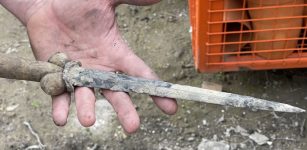 Medieval Bollock Dagger – Also Known As Kidney Dagger Discovered In Belgium
Archaeology | Mar 30, 2022
Medieval Bollock Dagger – Also Known As Kidney Dagger Discovered In Belgium
Archaeology | Mar 30, 2022 -
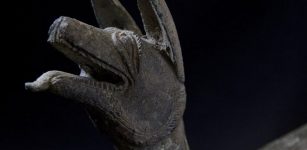 Beautiful And Unique Ancient Roman Hoard Discovered In UK
Archaeology | Oct 3, 2017
Beautiful And Unique Ancient Roman Hoard Discovered In UK
Archaeology | Oct 3, 2017 -
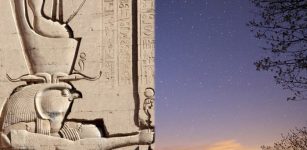 Ancient Egyptians Knew About ‘Demon Star’ Algol’s Variability 3,000 Years Before Western Astronomers
Archaeology | Nov 13, 2018
Ancient Egyptians Knew About ‘Demon Star’ Algol’s Variability 3,000 Years Before Western Astronomers
Archaeology | Nov 13, 2018 -
 Kindred Spirits: Why Did The Irish Build A Monument In Honor Of Native Americans?
Ancient History Facts | Oct 22, 2016
Kindred Spirits: Why Did The Irish Build A Monument In Honor Of Native Americans?
Ancient History Facts | Oct 22, 2016 -
 Scientific Disagreement Over The Bronze Age Tin Ingots From The Uluburun Shipwreck
Archaeology | Sep 25, 2023
Scientific Disagreement Over The Bronze Age Tin Ingots From The Uluburun Shipwreck
Archaeology | Sep 25, 2023 -
 Unique Over 1,000-Year-Old ‘Telephone’ Invented By A Lost Forgotten Civilization With No Written Language
Civilizations | Aug 24, 2018
Unique Over 1,000-Year-Old ‘Telephone’ Invented By A Lost Forgotten Civilization With No Written Language
Civilizations | Aug 24, 2018 -
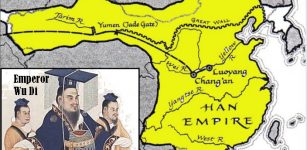 What Is Pax Sinica?
Ancient History Facts | Apr 26, 2018
What Is Pax Sinica?
Ancient History Facts | Apr 26, 2018 -
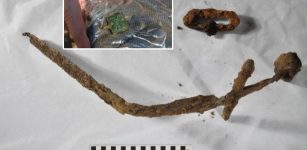 Crusader-Era Sword Discovered At Previously Unknown Burial Site In Finland
Archaeology | Oct 16, 2023
Crusader-Era Sword Discovered At Previously Unknown Burial Site In Finland
Archaeology | Oct 16, 2023 -
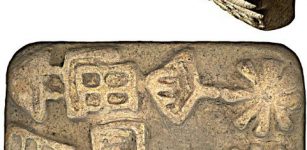 Royal Inscription Of Naram-Sîn Of Akkad: The First Ancient King To Use Blocks For Printing Bricks
Artifacts | Jul 28, 2016
Royal Inscription Of Naram-Sîn Of Akkad: The First Ancient King To Use Blocks For Printing Bricks
Artifacts | Jul 28, 2016 -
 Ancient Mantis-Man Petroglyph Discovered In Teymareh, Iran
Archaeology | Mar 16, 2020
Ancient Mantis-Man Petroglyph Discovered In Teymareh, Iran
Archaeology | Mar 16, 2020 -
 On This Day In History: Treaty of York Was Signed – On Sep 25, 1237
News | Sep 25, 2016
On This Day In History: Treaty of York Was Signed – On Sep 25, 1237
News | Sep 25, 2016 -
 On This Day In History: Gutenberg Prints The First Bible – On Feb 23, 1455
News | Feb 23, 2017
On This Day In History: Gutenberg Prints The First Bible – On Feb 23, 1455
News | Feb 23, 2017 -
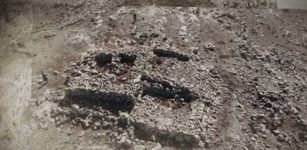 Controversial ‘Anomaly’ Discovered On Mount Ebal Could Be Biblical Joshua’s Altar
Biblical Mysteries | Apr 6, 2020
Controversial ‘Anomaly’ Discovered On Mount Ebal Could Be Biblical Joshua’s Altar
Biblical Mysteries | Apr 6, 2020 -
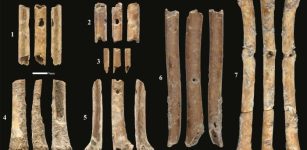 12,000-Year-Old Flutes Made From Bird Bones – Discovered
Archaeology | Jun 10, 2023
12,000-Year-Old Flutes Made From Bird Bones – Discovered
Archaeology | Jun 10, 2023 -
 6,000-Year-Old Bizarre, Mouthless ‘Alien’ Mask Unearthed In “The Salt Pit” Settlement In Northeast Bulgaria
Archaeology | Nov 20, 2020
6,000-Year-Old Bizarre, Mouthless ‘Alien’ Mask Unearthed In “The Salt Pit” Settlement In Northeast Bulgaria
Archaeology | Nov 20, 2020 -
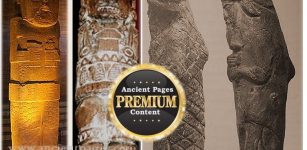 Mysterious Water Indians: Brotherhood Of Semi-Divine Beings Described As Half Men And Half Fish
Ancient Mysteries | Jul 8, 2014
Mysterious Water Indians: Brotherhood Of Semi-Divine Beings Described As Half Men And Half Fish
Ancient Mysteries | Jul 8, 2014 -
 Baby God Hermes Started His Life As A Liar And Trickster
Featured Stories | Dec 25, 2020
Baby God Hermes Started His Life As A Liar And Trickster
Featured Stories | Dec 25, 2020 -
 Underground Bronze Treasures Unearthed In 2,300-Year-Old Chengdu, China’s Sichuan Province
Archaeology | Mar 7, 2017
Underground Bronze Treasures Unearthed In 2,300-Year-Old Chengdu, China’s Sichuan Province
Archaeology | Mar 7, 2017 -
 Freemasons Secrets – American Democracy Is Part Of An Ancient Universal Plan – Secret Societies’ Role – Part 3
Ancient Mysteries | Jul 14, 2018
Freemasons Secrets – American Democracy Is Part Of An Ancient Universal Plan – Secret Societies’ Role – Part 3
Ancient Mysteries | Jul 14, 2018 -
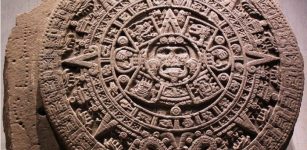 On This Day In History: Aztec Calendar Stone Rediscovered – On Dec 17, 1790
News | Dec 17, 2016
On This Day In History: Aztec Calendar Stone Rediscovered – On Dec 17, 1790
News | Dec 17, 2016

